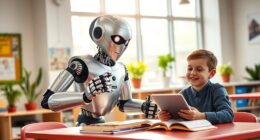We’ve discovered the key to unlocking classroom potential: personalized learning.
With this transformative approach, we can revolutionize education and empower every student to thrive.
By tailoring learning experiences to individual needs, we foster improved student engagement and enhance academic performance.
Teachers become more effective in guiding and supporting students, while promoting autonomy and independence.

The evidence is clear: personalized learning liberates students to reach their full potential, paving the way for a brighter future.
Key Takeaways
- Personalized learning can lead to increased student engagement, motivation, and academic achievement.
- Students are empowered to take ownership of their learning, develop critical thinking and problem-solving skills, and cultivate a sense of responsibility.
- Autonomy in learning can have a positive impact on student engagement, motivation, achievement, and the development of critical thinking skills.
- Self-directed learning promotes student responsibility, independent thinking, personalized exploration, lifelong learning habits, and preparation for real-world challenges.
Improved Student Engagement
Improved student engagement is a critical component in harnessing the power of personalized learning in our classrooms. When students are motivated and actively involved in their learning, they become more invested in their education and are more likely to succeed. Research has shown that personalized instruction, tailored to individual student needs, increases student motivation and engagement. By providing students with learning experiences that are relevant and meaningful to their lives, they’re more likely to be actively engaged in the learning process.
One approach to improving student engagement is through the use of individualized instruction. This method allows for the customization of learning experiences to meet the unique needs and interests of each student. By incorporating students’ interests, abilities, and learning styles into the curriculum, teachers can create a more personalized and engaging learning environment. This individualized approach not only increases student motivation but also promotes a sense of ownership and autonomy in their learning journey.
Enhanced Academic Performance
Through personalized learning, we can achieve higher academic performance by tailoring instruction to meet the unique needs of each student. This approach allows for individualized assessment, where educators can evaluate students’ strengths and areas for improvement in a more precise and targeted manner.

By understanding each student’s specific learning style, preferences, and abilities, teachers can design a customized curriculum that maximizes their potential. Research has consistently shown that personalized learning leads to improved academic outcomes, including higher test scores, increased retention of knowledge, and enhanced critical thinking skills.
Additionally, personalized learning fosters a sense of ownership and empowerment among students, as they’re actively involved in their own education. By adopting this approach, we can create a liberating educational environment that supports and nurtures students’ academic growth and success.
Tailored Learning Experiences
One key aspect of personalized learning is providing students with tailored learning experiences that meet their individual needs and preferences. This approach recognizes that each student is unique and requires a personalized approach to education. Adaptive instruction and individualized curriculum are two important tools that can be used to create tailored learning experiences.
Adaptive instruction involves using technology to adjust the pace and content of instruction based on the student’s individual progress and needs. This allows students to learn at their own pace and ensures that they aren’t overwhelmed or bored by material that’s either too challenging or too easy. By adapting the instruction to meet the student’s needs, educators can provide a more effective and engaging learning experience.

Individualized curriculum takes this concept a step further by tailoring the content of instruction to the student’s specific interests, strengths, and goals. This approach recognizes that students learn best when they’re engaged and motivated, and by aligning the curriculum with their individual needs and preferences, educators can create a more meaningful and relevant learning experience.
Research has shown that tailored learning experiences can lead to improved academic outcomes, increased motivation and engagement, and a greater sense of ownership over one’s own learning. By personalizing the learning experience, educators can empower students to take ownership of their education and unlock their full potential.
Increased Teacher Effectiveness
We have found that implementing personalized learning strategies has significantly enhanced our effectiveness as teachers. By engaging in targeted teacher training programs, we’ve gained the necessary skills and knowledge to effectively implement personalized learning approaches in our classrooms. This training has equipped us with the tools to analyze and interpret student data, allowing us to tailor our instruction to meet individual student needs. As a result, we’re able to provide timely and targeted interventions, ensuring that each student receives the support they require to succeed.
The use of data analysis also enables us to monitor student progress and make informed instructional decisions. Furthermore, personalized learning has allowed us to build stronger relationships with our students, fostering a sense of trust and collaboration in the classroom. These factors combined have significantly increased our effectiveness as educators, leading to improved student outcomes and engagement.

This enhanced effectiveness in the classroom is further amplified by the way personalized learning promotes student autonomy.
Promotes Student Autonomy
Implementing personalized learning strategies hasn’t only increased our effectiveness as teachers, but it has also empowered students to take ownership of their learning through the promotion of student autonomy.
Student empowerment is at the core of personalized learning, as it allows students to have more control over their educational journey. By encouraging self-directed learning, students become active participants in their own education, making choices about what, how, and when they learn.
Research shows that when students have the autonomy to make decisions about their learning, they’re more engaged and motivated, leading to higher levels of achievement. Self-directed learning fosters critical thinking skills, problem-solving abilities, and a sense of responsibility.

Frequently Asked Questions
How Can Personalized Learning Support Students With Special Needs or Learning Disabilities?
Personalized learning can support students with special needs or learning disabilities by supporting inclusion and offering differentiated instruction. By tailoring learning experiences to individual strengths and needs, personalized learning helps students reach their full potential.
What Are Some Potential Challenges or Drawbacks of Implementing Personalized Learning in the Classroom?
Some potential challenges or drawbacks of implementing personalized learning in the classroom include the need for extensive teacher training, access to technology, and ensuring equitable opportunities for all students.
How Can Personalized Learning Help Address the Individual Learning Pace and Style of Each Student?
Personalized learning addresses individual learning pace and style by providing individualized pacing and customized instruction. Research shows that students who receive personalized instruction experience higher levels of engagement, motivation, and academic achievement.
Are There Any Specific Technology Tools or Platforms That Can Aid in Delivering Personalized Learning Experiences?
There are various technology tools and adaptive platforms available that can significantly enhance personalized learning experiences. These tools provide individualized support, adapt to different learning styles, and allow for flexible and interactive learning.

What Are Some Strategies or Best Practices That Teachers Can Use to Effectively Implement Personalized Learning in Their Classrooms?
To effectively implement personalized learning in our classrooms, we can utilize differentiation strategies and adopt a student-centered approach. By tailoring instruction to individual needs and interests, we can unlock each student’s potential for success.
Conclusion
In conclusion, personalized learning has proven to be a game-changer in unlocking the full potential of students in the classroom. The evidence-based research clearly shows that it leads to improved student engagement, enhanced academic performance, tailored learning experiences, and increased teacher effectiveness.
By promoting student autonomy, personalized learning empowers students to take control of their education and explore their individual interests and strengths.
As educators continue to embrace this approach, the possibilities for student success and growth are limitless.












